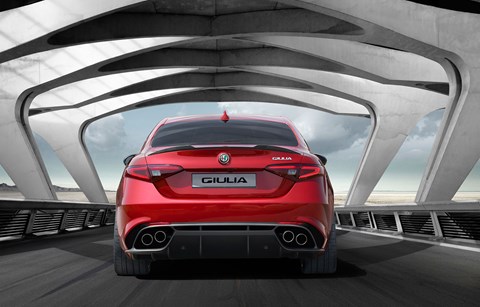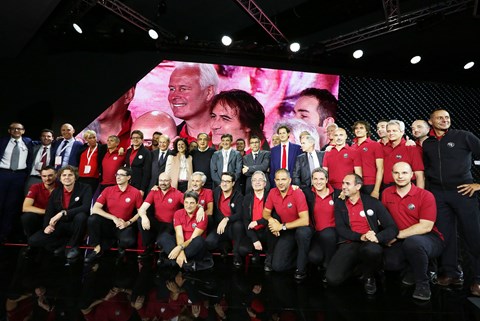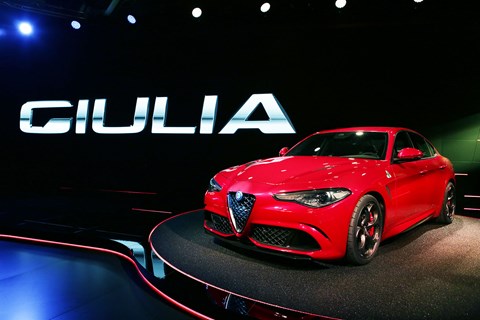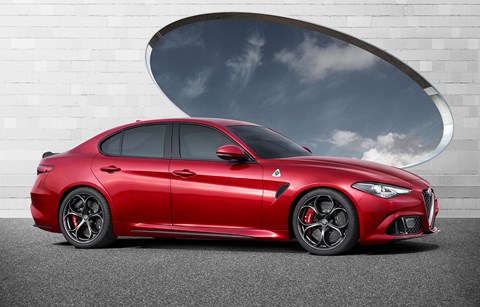► Chief engineer on new Alfa Romeo Giulia
► Zero to launch in just 2.5 years
► Technical insight, strategy revealed
Judging by the reaction online, it’s difficult not to conclude that Alfa Romeo has wowed the world with its new Giulia saloon. While not everybody was smitten with its looks, unveiled to the world at an event in Milan on 24 June 2015, the whole motoring fraternity certainly sat up and took notice.
Alfa is continuing to fettle the new compact exec ahead of sales starting in spring 2016. Hence our spies caught still-disguised Giulias on test near the Nurburgring in Germany this week, as the development programme moves into the final validation testing phase.
Before more details are announced at the Frankfurt motor show, CAR magazine caught up with the programme’s chief engineer Philippe Krief for an exclusive one-to-one interview to hear the Giulia’s full technical background. We asked him what the knock-out features on the new car are. Read on for seven pearls of insight we learned.

1) The Alfa Romeo Giulia was developed in just two-and-a-half years
This 159 successor has been a long-time coming after numerous delays: the earlier front-wheel drive programme was canned in its entirety, deemed untrue to the brand after Fiat CEO Sergio Marchionne ordered a more radical replacement. ‘You ask every car maker: doing a car in two years, everyone will tell you it’s not possible,’ says Krief. ‘The industry standard says four, the longest say five years, everywhere in the world. We had to do it in two and a half years. Marchionne said – and he’s right – the only way to achieve that is to be different.’ Click here to read Sergio Marchionne on the Giulia.
2) The skunkworks mentality and the team of 10
Marchionne authorised a crack skunkworks team to lead the Giulia project. Krief remembers the call-up well. ‘It was 29 April 2013. I was working at Ferrari and received a phone call saying “You have to come and do the new Alfa, we have to do something totally different. So please take a bunch of guys, go somewhere and think about that. You have two years and two months!”’ He appointed a team of 10 specialists in different departments to set the parameters for the programme and they installed themselves away from the usual R&D centre. ‘We were together always, so we had a huge amount of ideas and a quick decision-making process that you can’t have in a big company.’

3) Why the Giulia uses plenty of aluminium and carbonfibre
‘We had two targets: first, weight-to-power ratio,’ says Krief, who’s internally dubbed head skunk (now that’s a business card!). ‘We knew that we wanted to have a car around 1500kg for the Cloverleaf. Then we needed to do the optimisation, to decide where we wanted to save weight, where we could afford to have normal steel. We also decided on the cost criteria: you have to save weight where it’s efficient, but to save weight you always have to pay. On the door it’s efficient, if I pay X I can save a lot of weight; in other areas it’s not that efficient because you only save a little weight and you pay a lot. Suspension arms are mostly aluminium, front and rear, the engines are aluminium, the doors and fenders are all in aluminium, the boot on this one [the Cloverleaf] is carbonfibre, the roof also, we have also the propshaft in carbonfibre and structure of the seats.’
4) There’s a little bit of Ferrari sparkle in the handling
Krief was a senior engineer at Ferrari and promises there’s a little bit of Maranello magic in the new Giulia’s chassis dynamics. ‘I worked on the 458, the Speciale especially,’ he tells CAR. ‘Ferrari had a big advantage of having rear-wheel drive, so it’s exactly the same kind of stuff we wanted to put on the Giulia, this kind of feeling… It has to be precise, very quick, very agile, very stable. It drives fantastically really.’

5) The Cloverleaf can send all its torque to a single rear wheel
Over to the chief engineer to explain the torque vectoring available on the new Giulia. ‘You have a differential, two clutches, there’s always torque coming, even if you’re not on the throttle. Thanks to the torque vectoring, this torque can be split front and rear, left and right. It can create whatever you want: to start stable, have oversteer, then stable, understeer, you can do what you want because this clutch is very fast, the control is very fast… Today the limit of the car is given by the tyres but here you have to think that once you are at the tyre’s limit, it’s like you have a hand above that can add an extra element. You can send 100% to one wheel, it can send everything to one wheel, or another.’
6) The V6 engine is an Alfa classic
‘The V6 is a ground-up build,’ Krief vows. ‘Twin turbos, 90 degree bank, what was important for us was the feeling, it’s not necessarily the amount of torque. When you drive the car, when you accelerate, you can have all the torque suddenly then nothing, or you can have torque which is increasing, increasing, increasing: we use the amount of torque and we tune it to always have this situation, this feeling. Torque is dependent on gear choice: on first and second gear, you can have a huge amount of torque, here we are very progressive, on third and fourth, we are still progressive, but on fifth and sixth gear you have less torque because here you are looking for power. So we give more torque on the lower revs. Yet even in sixth gear, you accelerate and then vooom! There will be other engines of course. We will show these engines in Frankfurt.’ Will there be a four-cylinder Giulia? ‘Probably. And we are package-protected for V6 diesel, we can install it in the car and after we can decide whether to put it in or not.’
7) The Giulia’s active aero changes shape as you drive
‘We wanted the maximum of everything, best engine, weight, suspension, tyres and torque vectoring, and best possible aerodynamics,’ says Krief. ‘You have to create downforce, it increases the performance of your tyres. So we’ve developed this device to increase downforce in corners. We start from the basis where the car has natural downforce, but then we increase it in a bend: so in curves, the splitter is working to give you more downforce; go back to a straight line and we want low Cx, low drag. The Giulia has two electric actuators linked to the ECU that understands if you’re in a corner or a straight line, whether you’re in an understeer or oversteer situation, and in respect of that decides how to move the splitter.’
